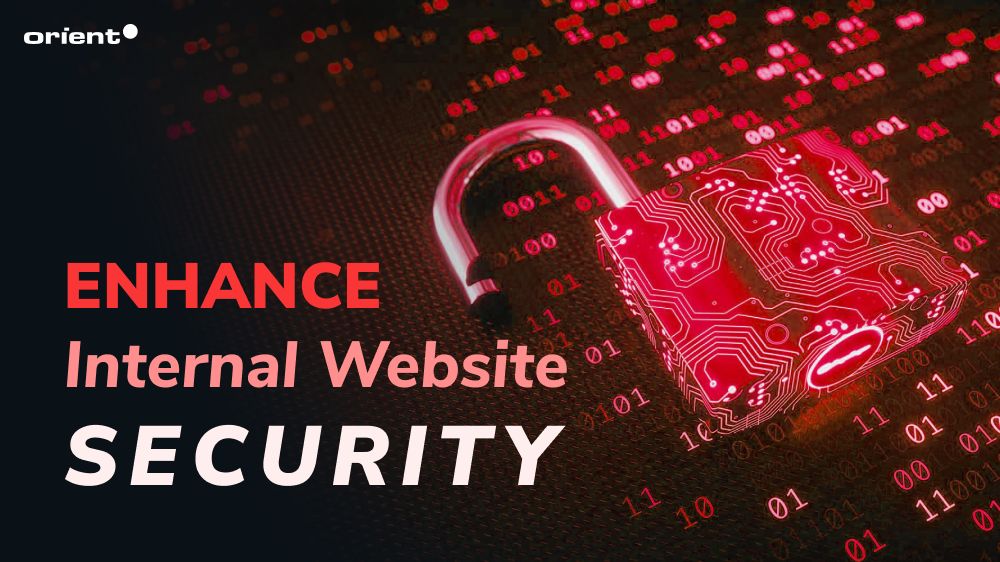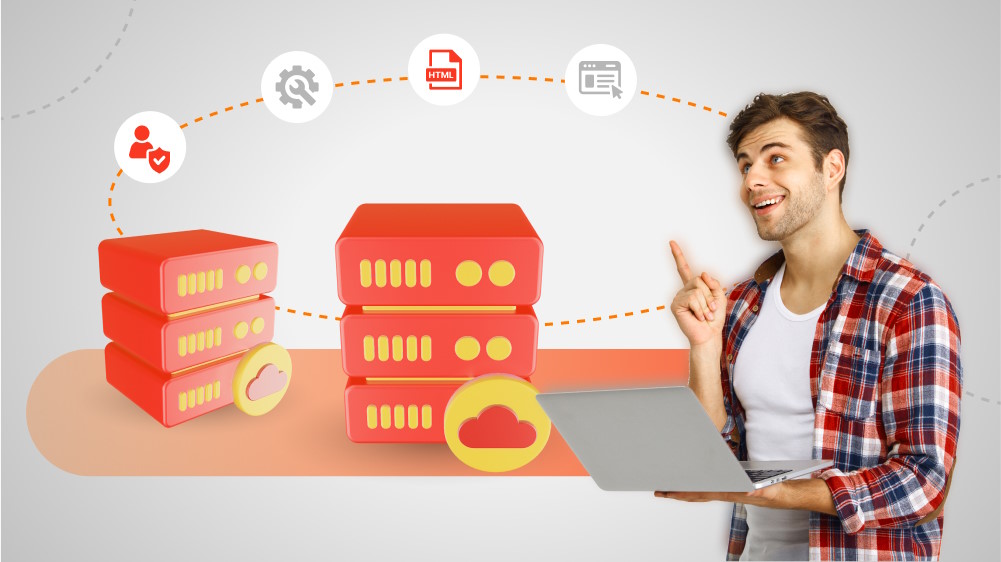This Is How You Enhance Internal Website Security

Content Map
More chaptersAs we are living in the digital era, we are often reminded to be careful and keep ourselves safe on the Internet. This entails everything we do in the digital common space, be it storing or exchanging information.
On a business scale, most businesses are acutely aware of the potential external security threats like viruses, worms, phishing or ransomware. However, internal, unseen threats are often overlooked, posing serious security risks to companies. Insiders are the main cause of breaches in the past 12 months, according to Forrester Research, with employees accidentally misusing their own data accounting for 36% of data breaches.
Today’s article will discuss the most common internal security threats and how to strengthen your defenses against them.
Key Takeaways:
- Businesses tend to overlook internal network security. However, it is just as crucial as external website security.
- The main reasons leading to insider security threats are negligent employees or contractors, digital theft, or unauthorized access.
- Defense strategies against security threats include rigorous access control, robust security policies, and regular monitoring and auditing.
What Is an Internal Website?

An internal website, or intranet, is a private, secure network accessible only to an organization’s employees or authorized users. It utilizes technologies like web browsers and servers to provide a centralized hub for company news, resources, applications, and communication tools, enhancing internal operations and collaboration.
Internal websites are used to serve a multitude of objectives, including:
- Internal communication tool. This entails newsletters, blogs, newsfeeds, and discussions,
- Internal information management,
- Enhanced collaboration, and
- Employee engagement.
A Quick Look at Global Cybersecurity Statistics

- Two out of every three occurrences involving insider threats are caused by the negligence of employees or contractors. The average time to contain a typical insider threat incident has climbed from 77 days in earlier studies to 85 days. (Proofpoint)
- The same study found that unintentional insider threats cost approximately $283,000 per incident. Due to their high frequency, these incidents resulted in a substantial annual cost of $3.8 million.
- Despite high confidence in organizational commitment and governance frameworks, 94.3 percent of Deloitte survey respondents have low to moderate confidence in the tools and technologies for managing third-party risk. Similarly, 88.6 percent have only limited confidence in the quality of risk management processes, highlighting an execution gap. (Deloitte)
The statistics demonstrate how costly and difficult it is to contain internal threats. The lack of confidence presented by survey respondents further underscores the need to raise insider threat awareness regarding the best information technology security practices.
Internal and External Threats

Internal and external security can be compared to safeguarding a building.
Internal web security safeguards you’re building from any insider threats. This means you will take a number of security measures, including installing security cameras, setting up alarms, hiring security guards, and controlling access to certain areas of the building. Employees working inside the building will need to be made aware of any security protocols as well.
External web security protects the perimeter of the building. This means building fences, placing security guards at the entrance, having security cameras to monitor the external environment, etc. These measures try to stop external malicious actors from infiltrating the premises. In the digital world, common security measures are firewalls, Virtual Private Networks (VPNs), Domain Name System (DNS) Security, Intrusion Detection and Prevention Systems (IDPS), and so on.
All in all, teams need to balance internal and external security measures to protect sensitive and employee data as comprehensively as possible.
Common Insider Cyber Risks

Weak Passwords
Weak passwords are a common entry point for malicious hackers to get access to sensitive data. According to a more recent study conducted by Verizon.com, 80% of hacking-related data breaches are still linked to weak passwords.
Unauthorized Access
Many of us might have been guilty of logging in to our devices and leaving them as is when leaving the office or our studies at home. This inadvertently grants direct access to digital intruders and puts intranet security at risk.
Unsecured Intranet Data
A large number of companies fail to encrypt intranet data, simply because they believe preventing unauthorized access is enough to safeguard it. This negligence is what leads to many of the data loss cases. Securing internal data in transit and at rest adds an extra layer of protection - even if hackers get their hands on the data, they won’t be able to understand it.
Multiple Device Logins and Unsecure Remote Access
The habit of automatically saving login credentials on multiple devices is a significant risk since you never know who might get their hands on your devices.
This risk is further increased when paired with remote access using public Wi-Fi, 3G, 4G or 5G networks that lack the essential corporate data protection measures.
Malicious Web Content
Any internal network is vulnerable to Trojan horses, viruses, and phishing attacks. Users need to exercise caution before visiting unfamiliar websites or downloading attachments, especially when using their smart devices, which often lack comprehensive protection.
Cloud intranet platforms are targets for hackers and DDoS attacks. Some only aim to disrupt the network security and overload the internal server as much as possible, while others target sensitive information like passwords.
Top Defense Practices for Strengthening Intranet Security
Robust Security Policies
The first step is to lay all the ground rules regarding insider security practices. The policies need to be clear and straightforward. You can refer to ISO/IEC 27001:2022 as your guide to information security, cybersecurity, and privacy protection.
- Have a password policy. Introduce a policy that requires employees to create strong passwords and change them every 60 days. You can refer to Google’s best practices in creating strong passwords.
- If your employees work remotely, have a remote access policy, e.g. require them to secure their home networks.
- Have clear steps for reporting any security incidents.
- Tailor the policies to different departments or job roles.
- Compliance with security standards and regulations must be taken into account as well.
Depending on the industry you operate in, there are certain safety rules and regulations that you need to comply with. For example, the medical industry needs to follow HIPAA, the financial sector needs to comply with PCI DSS, and companies in Europe need to comply with GDPR. Even if your industry has yet to issue specific standards, it is best to refer to general regulations and strictly follow them.
Data Encryption and Authentication
Encryption is a component of data security that involves encoding data to render it unintelligible and unrecognizable from its original form. Data encryption is an additional protection layer for sensitive data. For example, encrypting email communications ensures that the data is unreadable even when outsiders have access to it.
2FA is a security measure that ensures online account access is authenticated. Users enter their username and password, followed by a second factor, which could be a personal identification number, password, secret questions, or a keystroke pattern. This significantly mitigates the risk of unauthorized users entering the network.
Limit Access to Sensitive Information
It is crucial to know where data is stored so access can be granted accordingly. You should only grant necessary access, limiting any exposure to sensitive data and insider threats. It helps to take the zero trust approach, where trust is not assumed but earned, even for insiders. In addition to strict access controls, this approach regularly confirms the identity and access privileges to ensure trust.
Client certificates help ensure that only authorized clients or users access company information and services.
Securing Integration Endpoints
Modern intranet platforms offer everything employees need in one central repository. As convenient as this is, the multiple API integrations also introduce vulnerabilities to the intranet. Make sure you secure endpoints and regularly inspect them so they don’t expose private API data to any potential digital intruders. Keep in mind that endpoints are prime targets for those who want to access and manipulate sensitive information since endpoints are where employees interact with data and systems.
Regular Auditing and Data Backup
Cyber threats are ever-evolving; hence your IT security team needs to regularly conduct audits. This involves behavior analytics to detect any malicious intent or unauthorized activities on the intranet platform, reviewing access logs, system configurations or access privileges.
In case of a data breach, disaster, or system failure, you should have data backups. The task should be performed regularly, with multiple copies stored in multiple locations. You also need to regularly check the backup process to make sure the data is not lost or corrupted.
Awareness Training for Employees
To put everything we discussed into practice, your employees need to be able to implement the policies effectively. Educating your employees will help you achieve this goal. Here are some practical tips:
- Keep the training short and simple. Provide employees with easily digestible training sessions.
- Make sure employees understand what kind of data is considered sensitive and how it can be exploited.
- When management actively participates in the training process, employees tend to approach the session with higher levels of seriousness and engagement.
Keep Your Data Safe
Orient Software keeps your network data safe during every stage - from the discovery of sensitive data to the continuous prevention of data leaking. With a proven track record, we deliver highly secure solutions that offer comprehensive protection across diverse domains and networks. Contact us today to safeguard your data!







